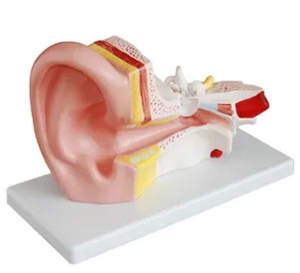In the journey of exploring the mysteries of the human body, the anatomical model of the middle ear, with its unique design and precise structure, has become a bridge connecting the complex physiological system of the inner ear and the outer ear. The establishment of this role not only stems from the scientific and educational value of the model itself, but also lies in its wide application and far-reaching influence in medical education, clinical practice and scientific research.
First, the anatomical model of the middle ear visually demonstrates the close connection between the inner ear and the outer ear. From the vibration of the tympanic membrane, to the transmission of the ossicular chain, to the disturbance of the inner ear lymphatic fluid by the oval window membrane, a series of complex and delicate processes are vividly reproduced in the model. By observing and manipulating the model, students can clearly see how the sound travels from the outer ear to the middle ear and then further to the inner ear, so as to gain a deep understanding of the connection mechanism between the inner and outer ears.

Secondly, it plays a vital role in medical education. It is not only an important tool for students to learn the structure and function of the middle ear, but also a key link to train students' clinical thinking ability and practical operation skills. With the help of the model, students can more intuitively understand the mechanism of middle ear diseases, clinical manifestations and treatment methods, and lay a solid foundation for future clinical work.
In addition, it plays an irreplaceable role in clinical practice. Doctors can use the model for surgical simulation and skill training to improve surgical success and patient safety. At the same time, the model can also be used as an auxiliary tool for doctor-patient communication to help patients better understand their own conditions and treatment plans, and enhance treatment confidence and cooperation.
To sum up, the anatomical model of the middle ear has become a bridge to understand the connection between the inner ear and the outer ear because it plays an irreplaceable role in medical education, clinical practice and scientific research. It not only helps students and doctors better understand the structure and function of the middle ear, but also drives the development and progress of medical science.
